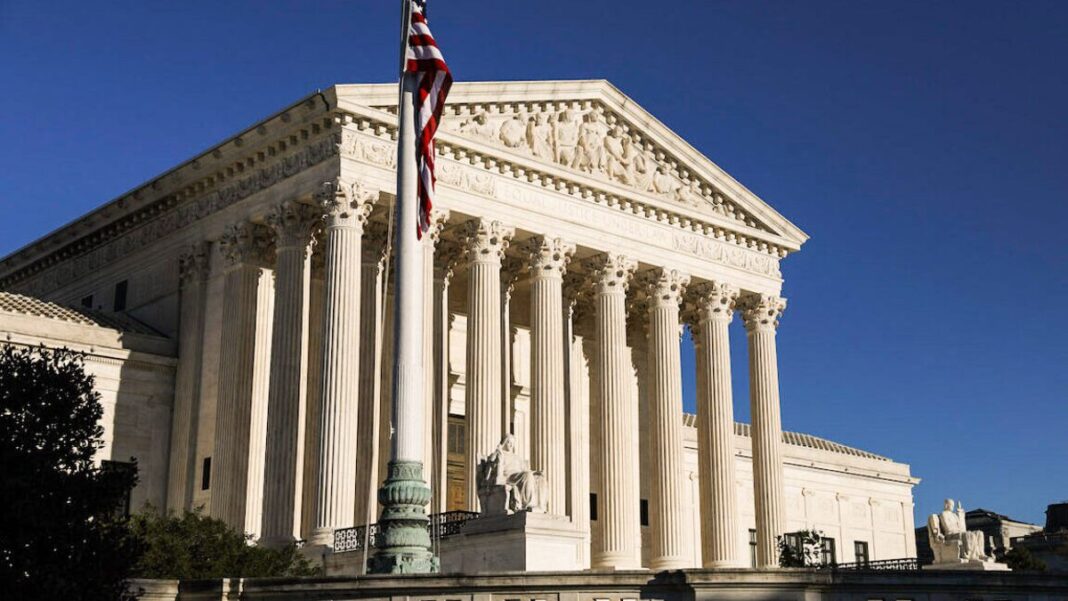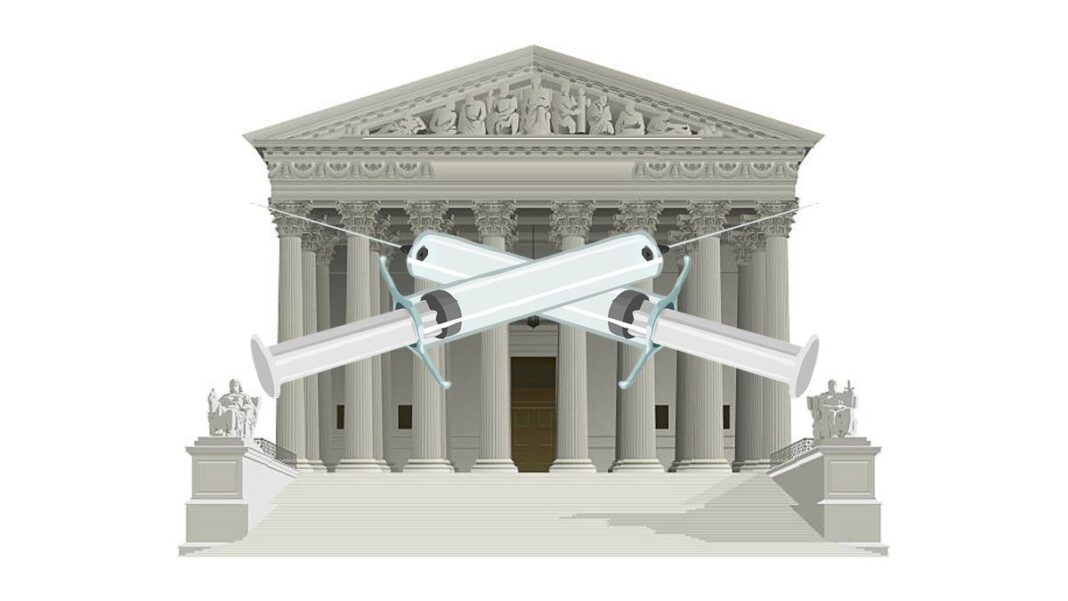
The Supreme Court on Thursday blocked the Biden administration’s COVID-19 vaccine mandate for private businesses but decided to let a separate regulation that requires health care workers to get a vaccine take effect.
In a 6–3 ruling, justices halted the mandate for all private employers with 100 or more workers, ruling the states and companies that challenged the rule were likely to succeed.
Biden administration officials had argued that the Occupational Safety and Health Act (OSHA) of 1970 gave them the authority to impose the mandate, but a majority of justices disagreed.
“Applicants are likely to succeed on the merits of their claim that the Secretary lacked authority to impose the mandate. Administrative agencies are creatures of statute. They accordingly possess only the authority that Congress has provided. The Secretary has ordered 84 million Americans to either obtain a COVID–19 vaccine or undergo weekly medical testing at their own expense. This is no ‘everyday exercise of federal power.’ It is instead a significant encroachment into the lives—and health—of a vast number of employees,” the majority wrote in a slip opinion.
The ruling came from Justices John Roberts and Samuel Alito, George W. Bush nominees; Clarence Thomas, a George H. W. Bush nominee; and Justices Neil Gorsuch, Brett Kavanaugh, and Amy Coney Barrett, all Trump nominees.
Justices Breyer, a Clinton nominee, and Sonia Sotomayor and Elena Kagan, both Obama nominees, dissented.
They wrote in their dissent that the law in question did not limit the labor secretary’s powers.
The majority “impose[d] a limit found no place in the governing statute,” they asserted.
“Not so,” the majority rejoined. “It is the text of the agency’s Organic Act that repeatedly makes clear that OSHA is charged with regulating ‘occupational’ hazards and the safety and health of ’employees.’”
While Solicitor General Elizabeth Prelogar in an earlier brief did not dispute that OSHA is limited in regulating “work-related dangers,” she claimed that the risk of contracting COVID-19 qualifies as such a danger.
“We cannot agree,” the majority continued. “Although COVID-19 is a risk that occurs in many workplaces, it is not an occupational hazard in most. COVID-19 can and does spread at home, in schools, during sporting events, and everywhere else that people gather. That kind of universal risk is no different from the day-to-day dangers that all face from crime, air pollution, or any number of communicable diseases. Permitting OSHA to regulate the hazards of daily life—simply because most Americans have jobs and face those same risks while on the clock—would significantly expand OSHA’s regulatory authority without clear congressional authorization.”
The ruling means the mandate is blocked while the case goes back to the U.S. Court of Appeals for the Sixth Circuit, which overturned a stay that had been imposed by a different appeals court.
OSHA is part of the Department of Labor.
Missouri Attorney General Eric Schmitt, a Republican who brought one of the challenges against the mandate, said in a statement the ruling was “a massive win for millions of workers and businesses across the country, including Doolittle Manufacturing here in Missouri, who would’ve had to shutter their doors if this mandate was not halted.”
“While we’re disappointed in the Supreme Court’s ruling on our lawsuit against the health care worker vaccine mandate, that fight is far from over, and the case is still ongoing,” he added.
Schmitt was referring to a majority of justices agreeing to lift lower court orders that blocked a separate Biden administration mandate, imposed by the Department of Health and Human Services’ Centers for Medicare & Medicaid Services (CMS).
The CMS mandate, which does not allow a testing opt-out, covers over 17 million health care workers.
Congress granted authority to the health secretary to promulgate, as a condition of a health care facility’s participation in Medicare and Medicaid, requirements that he or she “finds necessary in the interest of the health and safety of individuals who are furnished services in the institution,” the majority of the court said in their ruling.
While a vaccine requirement has never before been imposed, “we agree with the government that the Secretary’s rule falls within the authorities that Congress has conferred upon him,” they added.
Justices falsely said that getting a COVID-19 vaccine would “substantially reduce the likelihood that health care workers will contract the virus and transmit it to their patients,” which does not align with studies and real-world data on the effect of vaccination against the Omicron variant of the CCP (Chinese Communist Party) virus.
“The rule thus fits neatly within the language of the statute. After all, ensuring that providers take steps to avoid transmitting a dangerous virus to their patients is consistent with the fundamental principle of the medical profession: first, do no harm. It would be the ‘very opposite of efficient and effective administration for a facility that is supposed to make people well to make them sick with COVID-19,’” they said.
The narrow 5–4 opinion saw Roberts and Kavanaugh join the Democrat-nominated trio of justices while Thomas offered a dissent that was joined by Alito, Gorsuch, and Barrett.
Thomas said that the government had not made a strong case that it was likely to succeed in the case, arguing the administration did not establish that the Medicare Act or any other law gives it the authority to impose a vaccine mandate in order for facilities to participate in Medicare or Medicaid.
“These cases are not about the efficacy or importance of COVID-19 vaccines. They are only about whether CMS has the statutory authority to force health care workers, by coercing their employers, to undergo a medical procedure they do not want and cannot undo. Because the Government has not made a strong showing that Congress gave CMS that broad authority, I would deny the stays pending appeal. I respectfully dissent,” Thomas said.
Cases involving the health care mandate will now go back to appeals courts for disposition.






